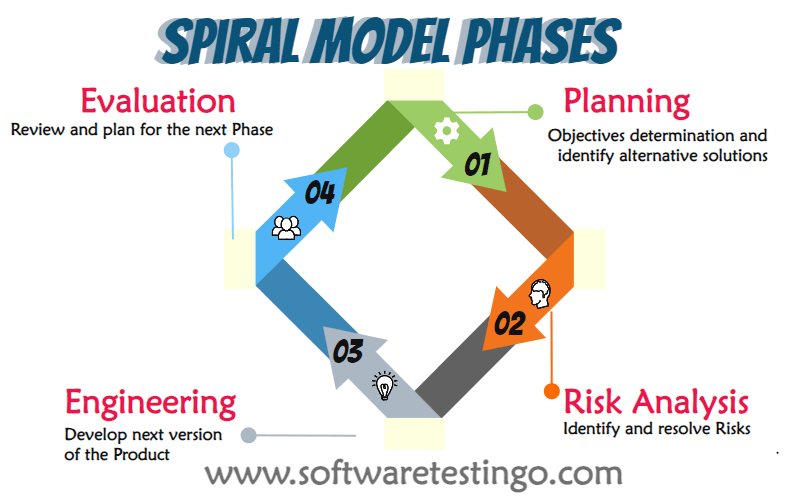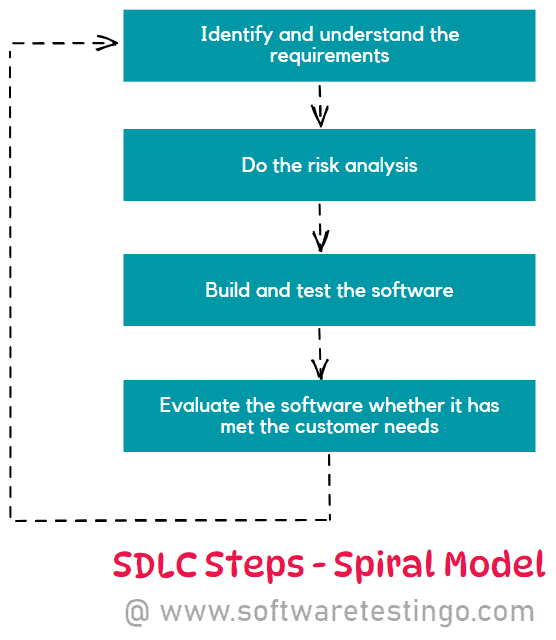Spiral Model Of Software Development in Software Engineering: The spiral model is a prominent software engineering methodology revolutionising software development. Barry Boehm originally proposed the spiral model.
The key features of the spiral model include early risk analysis (in the spiral model, ‘risk analysis’ is performed, which is the most important feature of the spiral model) and continual requirement gathering (spiral model advantages), identifying and mitigating potential challenges throughout the software development life cycle. Illustrated through a Spiral Model diagram, this dynamic approach allows for adaptability and continuous refinement.
The spiral model allows for incremental releases of the product (difference between prototype and spiral model), making it different from the strictly sequenced waterfall model (waterfall model vs spiral model).
The advantages of the Spiral Model include its effectiveness in managing uncertainties and accommodating changes during development. The spiral model is called a “meta” model as it provides a framework for choosing and blending other SDLC models (why it is called a meta-model). For example, the win-win spiral model incorporates prototyping, embodying flexibility and responsiveness to evolving project requirements.
While sharing similarities with incremental models, the Spiral Model sets itself apart by its explicit focus on risk assessment and management. Its phases involve constant evaluation and adaptation, aligning with the dynamic nature of software development projects.
However, like any methodology, the spiral model has disadvantages, including its complexity. Identifying potential drawbacks, such as the complexity associated with risk analysis and the potential for cost overruns, is essential.
In summary, the Spiral Model’s two dimensions, incremental development and risk analysis, form the backbone of its effectiveness in managing software development projects. This model stands out as a versatile and adaptable framework, embodying the essence of dynamic and risk-conscious software engineering practices.
Why Spiral Model Is Used?
The spiral model is utilized in software engineering due to its efficacy in addressing the inherent uncertainties and complexities, saving money and time at each phase of the SDLC process associated with the development process. But before going forward, let me clarify that when I say cost here, it means both cost of time and money.
Its primary strength lies in its iterative approach, allowing for continuous refinement and adaptation at each phase. The spiral methodology’s main goal is to optimize the overall cost of the software development process.
So, let’s discuss how we can save time and money during each phase step by using this model. Let’s start with the requirements phase first. At this stage, we must gather all the user requirements properly before beginning the design.
Gathering requirements alone is commonly perceived to consume more than 40% of the overall project time. However, if the spiral model is used, most of these efforts can be reused in later phases.
Spiral Model Phases
Now we will see different phases of the spiral model in detail:

Planning
At the start of every phase, requirements are collected from the customer, and objectives are identified. These objectives are elaborated on and analyzed in this quadrant. In this quadrant, more discussion with clients is done to collect their requirements, and if possible, a prototype is created in the client’s presence to evaluate the product quality.
Normally, during this phase of the requirement-gathering exercise, change requests are also seen from clients, and these requests are treated as risks for the next development phases.
Risk Analysis
Once the objectives are collected from the client, all possible solutions are evaluated in this quadrant for best potential. In this step, a prototype is developed using technology that can be changed easily if requested by a client later on. If any risks come up during the development of the prototype, they are identified and resolved in this phase.
Engineering
In the third quadrant, features are developed and tested. A new software version is available at the end of this time. In this step, all changes done in previous steps are implemented.
Evaluation
It is the last phase, where clients come and evaluate the product being developed. In this phase, the client tells us whether any changes need to be made to the previous version of the software. If yes, then what kind of changes are required? After getting client feedback, developers plan further development work for the next version.
Steps Of Spiral Model
Let’s understand the spiral model step by step:
- The First step is to start with an idea. This is usually the phase when developers or entrepreneurs develop new ideas to create a new product or software. A team of skilled personnel has also been selected to execute this project effectively and efficiently.
- The second step is to do a feasibility study on the idea. The feasibility study will help you determine the cost of software development required to build it, the time taken to develop it, and its functionality.
- The third step is creating a business plan based on the feasibility study results. The business plan should clearly define the Target Audience, Market Share, Estimated Cost of Software Development, etc.
- The Fourth step is to develop the initial prototype version of the product, which will help you prove your idea’s feasibility.
- The Fifth step is the prototype version’s User Acceptance Testing (UAT). This testing should be performed by target users as well. If feedback from UAT is positive, the next step is to identify and resolve risks.
- Once you are done with resolving risks, you can proceed to the final version of the software. This is when you will work on adding more features per your business plan or user requirements.
- Once this process is done, final testing should be performed, and all defects, if any, should be fixed.
- Finally, the product must be deployed so that users can use it.
- User feedback on the final product should be collected and analyzed to identify any further enhancements required in the future. This is exactly where the spiral model comes into the picture, as you will go back to the first phase of this model whenever your customer wants to change something or add new features later on.
- The cycle can be closed when all user requirements are satisfied or the business model ends.
Spiral Model Diagram
To understand easily the steps, you can check the below Spiral Model Diagram:

Spiral Model Advantages And Disadvantages
Here, we have discussed the advantages and disadvantages of the spiral model one by one:
Advantages Of Spiral Model
The spiral model has many advantages over other software development models. Some of these advantages are listed below:
- Risk Emphasis: The model prioritizes risk assessment and management throughout the project life cycle, facilitating early identification and mitigation of potential issues. This proactive approach enhances project success rates.
- Continuous Feedback: The Spiral Model underscores continuous feedback and refinements to meet customer requirements, ensuring satisfaction and adaptability to evolving needs.
- Flexibility and Adjustments: It allows for flexibility and adjustments during development, minimizing disruptions caused by changing requirements or unforeseen circumstances.
- Continuous Improvement: The model supports continuous improvement as each cycle builds on past lessons, enhancing expertise and overall efficiency.
- Early Validation through Prototyping: By incorporating prototyping in each cycle, developers can validate design decisions early, reducing rework efforts and improving overall efficiency.
- Stakeholder Involvement: Emphasizes stakeholder involvement and regular communication to meet expectations and build trust.
- Opportunities for Testing: It provides ample opportunities for testing throughout its cycles, enabling prompt detection and resolution of defects and ensuring high-quality software deliverables.
- Risk Assessment and Resource Allocation: Includes risk assessment, identifying project bottlenecks and aiding in resource allocation.
Disadvantages Of Spiral Model
- Complex Iteration Management: Managing and tracking multiple iterations is challenging due to detailed planning and execution.
- Project Scope Expansion: The iterative nature can sometimes cause the project scope to expand, leading to delays and increased expenses if changes are not controlled properly.
- Risk Management Neglect: Emphasizing risk analysis and neglecting proper risk management can result in issues later in the project.
- Resource-Intensive Documentation: Thorough documentation is time-consuming and resource-intensive, especially without proper management at the project’s start.
- Communication Challenges: Teams might need to change projects every round, making communication and collaboration challenging.
- User Involvement Difficulty: Continuous user involvement in every phase can be challenging without active engagement, potentially leading to insufficient feedback and unsatisfactory outcomes.
- Suitability for Project Size: The model is more suitable for large-scale projects that require flexibility but may not be optimal for smaller projects with limited budgets.
Conclusion:
The spiral model offers a unique risk-driven approach to iterative software development, providing several advantages over traditional methodologies. By repeatedly emphasizing risk analysis and mitigation across software evolution cycles, projects can surface and address uncertainties early, head off late-stage surprises, and incorporate user feedback through incremental prototype releases. While complex to implement fully, the spiral model qualifies as an adaptable “meta” process capable of integrating other development models within its phases.
For those considering the spiral model, especially on large, mission-critical systems, I encourage closely evaluating your team’s risk analysis expertise and bandwidth for conformance to the spiral process rigours. Start small by piloting low-risk aspects first before full commitment.
As we continue maturing software engineering best practices, I welcome your experiences or commentary on the spiral model’s real-world effectiveness. What challenges have you faced in applying it? How has its risk-based approach benefited your projects? Please share your tips, critiques or questions below to help strengthen this overview.
